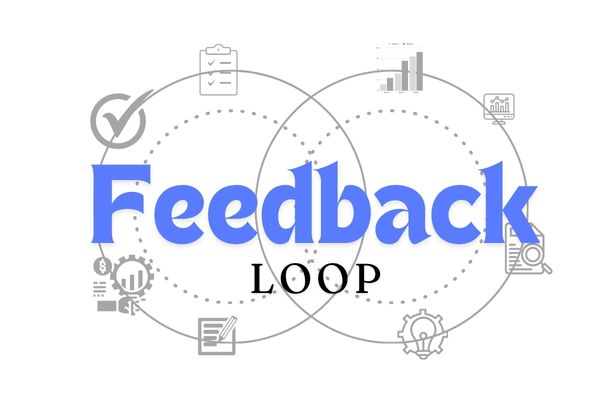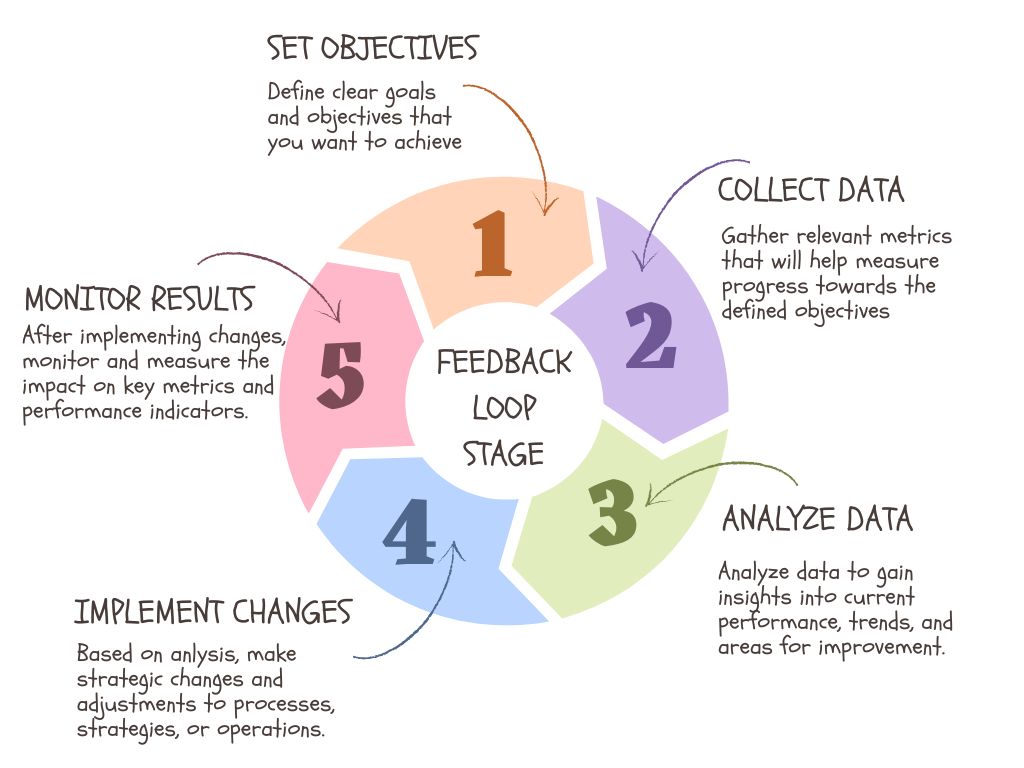
A feedback loop is a continuous process of improvement where the results of actions become inputs for subsequent actions. Let’s break it down further.
Consider a software development team working on a new application. They release an initial version to users and gather feedback on its performance, features, and usability. This feedback is carefully analyzed, and based on the insights gained, the team makes necessary adjustments and enhancements to the application. The updated version is then released to users again for feedback, restarting the feedback loop.
This process of collecting, analyzing, and applying data to refine operations is known as a feedback loop. It’s not just a one-time event; rather, it represents an ongoing dialogue between your business and its surroundings. This ongoing conversation empowers you to adapt swiftly, innovate effectively, and meet the evolving needs of your audience.
Components of a Feedback Loop
A feedback loop typically involves the following components:
- Input: This refers to the initial data, information, or actions that start the feedback loop. It could be customer feedback, performance metrics, user behavior data, or any other relevant input.
- Process: The input is processed or acted upon in some way, such as analyzing the data, making decisions, implementing changes, or taking corrective actions based on the input received.
- Output: The result or outcome of the actions taken in response to the input. This could be improvements in performance, changes in behavior, optimization of processes, or any other measurable impact.
- Feedback: The output from the process becomes new input for the next iteration of the loop. This feedback loop continues as the new input is processed, leading to further adjustments or improvements.

Benefits of a Feedback Loop
Feedback loops are crucial for continuous improvement and adaptation because they allow organizations to:
- Monitor Performance: Continuously track key performance indicators (KPIs) and metrics to assess how well objectives are being met.
- Identify Issues: Recognize areas of improvement or potential problems based on the feedback received from the output of previous actions.
- Implement Changes: Take corrective actions or make strategic adjustments based on the insights gained from the feedback loop.
- Measure Impact: Evaluate the effectiveness of interventions or changes by observing subsequent outputs and comparing them to desired outcomes.
Understanding Feedback Loops in Metrics-Driven Improvement
Feedback loops involve a cyclical process of setting objectives, measuring performance through relevant metrics, analyzing outcomes, and using insights to adjust strategies and actions. This iterative approach enables organizations to adapt and improve continuously based on data-driven feedback.
To achieve metrics-driven improvement using feedback loops, you need to:
- Set Clear Objectives: Define specific goals and desired outcomes that align with overall business objectives.
- Select Relevant Metrics: Identify key performance indicators (KPIs) and metrics that directly measure progress toward your business objectives.
- Regularly Monitor and Analyze: Continuously track and analyze metric data to assess performance and identify trends or areas for improvement.
- Make adjustments and Optimize Strategies: Use metric insights to make informed decisions, implement changes to accommodate the insights, and optimize strategies to drive better outcomes.
- Recheck Results: After implementing changes and adjustments, recheck the results to evaluate the impact on metrics and ensure alignment with desired outcomes. Thus repeat the loop.
Key Metrics and Feedback Loops
In today’s competitive business landscape, harnessing the power of metrics and feedback loops is essential for driving continuous improvement and achieving organizational excellence. By strategically utilizing key performance indicators (KPIs) and implementing iterative feedback loops, businesses can make data-driven decisions, optimize processes, and innovate to stay ahead in dynamic markets. Below are few key metrics and methods for establishing feedback loops to drive continuous improvement:
- Customer Satisfaction Score (CSAT):
- Metric: Measure customer satisfaction through post-interaction surveys or feedback ratings.
- Feedback Loop Implementation:
- Set Clear Objectives: Aim to improve CSAT scores to a certain benchmark level.
- Regular Monitoring and Analysis: Continuously collect and analyze CSAT data after customer interactions.
- Actionable Insights and Adjustments: Use feedback to identify pain points or areas for improvement (e.g., service quality, response time) and implement changes accordingly (e.g., staff training, process improvements).
- Iterative Improvement: Periodically reassess CSAT metrics to gauge the impact of implemented changes and adjust strategies as needed.
- Monthly Recurring Revenue (MRR):
- Metric: Measure the predictable revenue generated from subscription-based services on a monthly basis.
- Feedback Loop Implementation:
- Set Clear Objectives: Increase MRR by acquiring new customers and retaining existing ones.
- Regular Monitoring and Analysis: Continuously track MRR growth and analyze contributing factors (e.g., new sign-ups, upgrades, downgrades, cancellations).
- Actionable Insights and Adjustments: Identify reasons for MRR fluctuations (e.g., customer feedback, market trends) and adjust pricing, features, or marketing strategies accordingly.
- Iterative Improvement: Implement iterative changes to subscription plans based on feedback to optimize MRR trajectory.
- Churn Rate:
- Metric: Calculate the percentage of customers who stop using a product or service over a specified time-period.
- Feedback Loop Implementation:
- Set Clear Objectives: Reduce churn rate to improve customer retention and long-term revenue.
- Regular Monitoring and Analysis: Continuously monitor churn rate trends and identify patterns or triggers leading to customer attrition.
- Actionable Insights and Adjustments: Gather feedback from churned customers to understand reasons for leaving and implement retention strategies (e.g., improved customer support, product enhancements).
- Iterative Improvement: Implement targeted interventions based on churn analysis and measure the impact on reducing churn rate.
- Accounts Receivable (AR) Aging:
- Metric: Analyze the age of outstanding invoices to assess cash flow and financial health.
- Feedback Loop Implementation:
- Set Clear Objectives: Improve AR turnover by accelerating invoice collections and reducing overdue payments.
- Regular Monitoring and Analysis: Continuously track AR aging categories (e.g., current, 30 days overdue, 60+ days overdue) and identify bottlenecks in payment processes.
- Actionable Insights and Adjustments: Implement proactive measures to address payment delays (e.g., automated reminders, revised credit terms) based on customer feedback and payment behavior.
- Iterative Improvement: Optimize AR management processes based on feedback to streamline cash flow and reduce bad debt exposure.
Implementing feedback loops for the metrics that truly matter to your organization is paramount for meaningful progress and sustainable growth. Focusing on relevant KPIs aligned with your business objectives and customer needs allows you to extract actionable insights. Avoid chasing vanity metrics just because others do. Instead, drive targeted improvements and pave the way for strategic success in your business.
Conclusion
Incorporating metrics-driven improvement through feedback loops is instrumental in achieving continuous growth and success in business. By setting clear objectives, selecting relevant metrics, consistently monitoring and analyzing data, making informed adjustments, and optimizing strategies based on insights, organizations can adapt and thrive in dynamic market environments. Rechecking the results of implemented changes ensures that efforts remain aligned with business goals and leads to ongoing refinement and improvement. Embracing this iterative approach fosters a culture of data-driven decision-making and continuous improvement, ultimately positioning businesses for strategic success and competitiveness in their industries.


